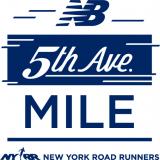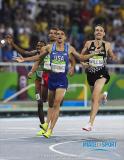Folders |
Matthew Centrowitz's Welcome To 'The Club' But Which Club?Published by
By Elliot Denman // Photo Courtesy Image of Sport "Welcome to the club." These are the words, whispered to Matthew Centrowitz, at the top of the podium, by Lord Sebastian Coe, that will forever resonate out of the Rio 2016 Olympic Games. They will continue to resonate all the way to the 110th edition of the NYRR Millrose Games to be held on Saturday, Feb. 11, 2017, at the New Balance Track and Field Center at The Armory. If he chooses to compete, newly crowned Olympic champion Centrowitz, for sure, will be a focus of major attention. His 2016 NYRR Wanamaker Mile win was surely an omen of big things to come in Rio – his meet-record 3:50.65 win over Nick Willis' 3:51.06, with Brit/Oklahoman Chris O'Hare a right-up-there third in 3:52.91 – was an incredible crowd pleaser. In another Rio-Millrose connection, the NYRR Wanamaker Mile is now positioned as the grand finale of a Saturday Armory schedule already full of highlights. Similarly, the Olympic 1500 final came on the final day of action at Estadio Olimpico. That Rio whisper? One Olympic 1500-meter champion to another. Obviously, you may think. But obviously not, if you think it out some more. Consider that there are a number of clubs which Lord Coe – acting, to some, in a mysterious manner – could have been referring to. He carries membership in three of them. Lord Coe's number one club now has 27 members – each a man and each a winner of the Olympic 1500 meters. Edwin Flack (Australia) in Athens 1896 to Matthew Centrowitz (USA) in Rio 2016. Then again, Lord Coe's in a second club that has just four members – Charles Bennett (1900), Arnold Jackson (1912), Albert Hill (1920) and the Lord himself (1980-84) – Great Britons who've run off with Olympic 1500 gold. And he's in a third club that is the most exclusive of all, its only member, as the lone man who has ever been able to win the Olympic 1500 final, and then win it again. Many have tried – to two-peat – but no man but Coe has ever succeeded. So that's three clubs for Lord Seb, but I can think of just two ready to initiate Our Matthew. There is that 27-member champions-of-all-nations club, 120 years in the making, referenced above, James Flack to Centro. And there's a three-member club – American men who have struck Olympic 1500-meter gold. There was James Lightbody, of course, the Indianan out of the Chicago Athletic Association who won at St. Louis in 1904. He was followed by Mel Sheppard – "Peerless Mel," out of Almonesson, Deptford Township, New Jersey, and New York's Irish-American Athletic Club – who was victorious at London in 1908. And now there's Centro – scion of the illustrious family sired by Matt Sr., former holder of the American 5000-meter record, 1976 Montreal Olympian at 1500 meters, and 1980 Olympian at 5000 meters (but a stay-at-home from Moscow with his boycotting USA teammates.) One hundred and eight years after "Peerless Mel" won at London in 4:05.4, Centro won at Rio in 3:50.00. So maybe that earns membership in yet another club – slowest winning time in 84 years, since Luigi Beccali, who won for Italy in Los Angeles in 1932 (and, following WW II, spent much of his life as a Long Islander and Floridian.) No man in that 13-man final was willing to "take it out." All 13 were convinced they could run a 48-second final lap after an opening 800-meter walk. So they played precisely into Centro's strategic hands. His last 400 wasn't 48, it was 50.5. He held the rail, maintained position, and defied the dozen chasers to run him down. And they could not. Not Algeria's Taouflik Makhoufi, the defending Olympic champion. Not Kenya's Asbel Kiprop, the 2008 Olympic champion, trying to win it all back. Not any of the other 10. The archives will show that Jakub Holusa of the Czech Republic was the fastest 1500 man at the Rio Olympics, with his first-round 3:38.31. But all it eventually led to was a ninth in the semifinals, and an exit from Estadio Olimpico. Centro had run 3:39.31 in the prelims, then 3:39.61 in the semis, He'd won the USA Trials in 3:34.09 and struck gold at the World Indoor Championships. So we knew he can run fast and we'd already known he's a brilliant strategist – having placed fourth at the 2012 London Games, as well as second at the 2013 Worlds and third in 2011. That put him in perfect position to join not one, but two clubs in Rio (one as member #27 on the roster of the champions out of all nations, the other as member #3 of the champions out of his own nation.) Time literally stood still as that Olympic 1500 final unfolded. It was astonishing, shocking really, to see so many quality runners refusing "to go" in the first two circuits. After those two minutes and 16 seconds, it was already impossible – even if your name was David Rudisha – to put a quality final time on the board. In that scenario, Matthew Centrowitz played his cards to perfection. In this golden process, he thus avoided potential membership in three less exclusive clubs. First of these is Americans who've run second in the 1500 at the Games, Uncle Sam's Silver Streakers. Its seven-man membership club is: Arthur Blake 1896, Frank Verner 1904, Abel Kiviat 1912, Glenn Cunningham 1936, Bob McMillen 1952, Jim Ryun 1968 and Leonel Manzano 2012. Second of these clubs is the Americans who've been third in the 1500 at the Games, the Bronze Brigade. Just four of these club cards have ever been issued, to: John Bray 1900, Lacey Hearn 1904, Norman Taber 1912 and Lawrence Shields 1920. He'd already been a member (#5) of the third of these clubs for the past four years, Americans who've run fourth in the 1500 at the Games. His four clubmates here are: David Hall 1900, David Munson 1904, John Paul Jones 1912 and Glenn Cunningham 1932. (This isn't considering Bernard Lagat, who ran third in 2000 and second in 2004, both for Kenya, before joining Team USA.) So that wraps it all neatly. Or not so neatly. Whichever, whatever, whenever the club, a very warm welcome to you, Mr. C. All this may now get some of you out there thinking where exactly do Team USA's 1500-meter women fit in? By running 3-4 in Rio, Jenny Simpson and Shannon Rowbury are now in some exalted, exclusive club company of their own. Question: Just how many of their predecessors had ever placed that high in the Games? Answer: Zero. The women's 1500 has been on the Games program since Munich 1972, and just four Americans had even made the top eight through the first nine of those races. Intriguingly, all four of them ran precisely eighth: Jan Merrill 1976, Ruth Wysocki 1984, Mary Decker Slaney 1988 and Marla Runyan 2000. Then Rowbury ran seventh in 2008 and fifth in 2012, only to see good friend/archrival Simpson beat her to the podium in Rio, by exactly 52/100ths of a second. But, best is known, no club membership was ever whispered to them. More news |










